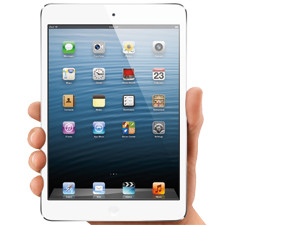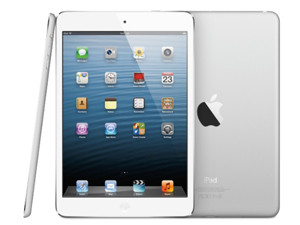
After months of speculation, Apple has officially unveiled the iPad Mini - a 7.9-inch version of the iPad.
The new tablet features a dual-core A5 processor, HD FaceTime camera, a 5MP iSight Camera on the back, with 1080p video recording, the new Lightning connector and 10 hours battery life.
The iPad mini is available in Wi-Fi and cellular models with built-in support for LTE and DC-HSDPA. The entry level 16GB Wi-Fi model has a starting price of $329.
Other products revealed by Apple included the fourth generation iPad, new iMacs, updated Mac Mini and the expected 13-inch MacBook Pro with Retina display.
At the special launch event, Apple was keen to emphasise the iPad Mini is a "concentration" rather than a reduction of the original iPad.
VP of worldwide marketing at Apple Phil Schiller took a swipe at competitors saying: "Others have tried to make tablets smaller than iPad and they've failed miserably. They are not great experiences."
According to Schiller the extra 0.9 inch the iPad Mini has on its 7-inch competitors translates to 35% more display area. "The technology inside the iPad Mini is equal to or better than the iPad 2 in every way. It is every inch an iPad."
MD of World Wide Worx, Arthur Goldstuck says the iPad Mini is "a little overpriced", given the competitive landscape into which it is being launched. "Amazon must be delighted that it cannot compete with the Kindle Fire on price," says Goldstuck.
"Having said that, the sudden appearance of the iPad 4 (or 'fourth generation iPad') is quite startling, given that it boasts a leap in processing power."
The fourth generation iPad features an A6X processor, and Schiller dubbed it a "powerhouse". "We are so far ahead of the competition, I can't even see them in the rear-view mirror," quipped Schiller.

During the presentation Schiller compared the iPad Mini to a device that, although not mentioned by name, was the Nexus 7 from Google. Goldstuck says the fact that Apple chose to compare the iPad Mini to Android devices and did not reference Windows 8 means that they "may not be taking it seriously enough".
"That would be a serious mistake. At the same time, it will take more than heavy marketing for Windows 8 to rise to the iPad challenge in the tablet landscape."
Goldstuck says the full significance of the launch lies in the fact that Apple has upped the game across its entire ecosystem. "An iPad Mini launch on its own would have been disappointing, and would have vanished under the coming Windows 8 marketing juggernaut. Clearly, Apple should never be underestimated, either in terms of their devices or their strategy."
Principal analyst at Ovum, Adam Leach says the iPad Mini marks a significant shift in Apple's strategy. "For the first time in its recent history it is responding to market pressures from its competitors, namely Google and Amazon in bringing a smaller tablet to market.
"Apple in the past has defined new products with new form factors and waited for the market to follow, in this instance Apple is following the market trend towards smaller cheaper tablet form-factors. This reflects a fundamental change in the way Apple operates."
In context
The tablet market is expected to exceed 130 million units in 2012, rising to 349 million units in 2017. According to Ovum, the projected compound annual growth rate of 22% over the next five years, makes tablets the fastest growing category of consumer electronics in history. Ovum estimates Apple currently has 54% of the global tablet market.
Tablet computing kicked off in 2002 with modified Windows XP and folding laptops, but it was Apple who took the world by storm in 2010 with its first generation iPad, reinventing the tablet world in its image and selling millions of units.
The iPad2, in 2011, offered an incremental upgrade and continued to sell well, and the 3rd generation iPad in 2012 raised the bar for emerging competition with its high resolution 'Retina' display.
Competing products, largely powered by Google's Android, struggled for market share until mid-2011, with Apple enjoying 81% of tablet sales. That changed in 2011-2012, with Apple's share shrinking to just 52%, driven by competitive pressure such as Amazon's aggressive entry with the Kindle Fire, a low-cost 7" device which powered Amazon to 21% market share in a year.
Steve Jobs was famously dismissive of 7" tablets in 2010, denying they offered any value to consumers. A smaller iPad will mark not only a major reversal on Jobs's legacy, but also the first time Apple's consumer division, traditionally several steps ahead of the market, has seen its hand forced by market pressure.
Going forward, the hotly contested patent litigation between Apple and Samsung, currently weighing in Apple's favour, will likely to continue. And 2013 will see a slew of competing products running a rapidly evolving Android OS, joined by new devices running Microsoft's Windows 8 tablet OS. The iPad, in any form factor, has a fight on its hands like never before.
Apple continues to enjoy strong support in South Africa. Apple's products enjoy relatively close price parity with overseas, while relatively few Android models are available, and sold at hefty premiums.
Additional reporting by Jon Tullet
Share